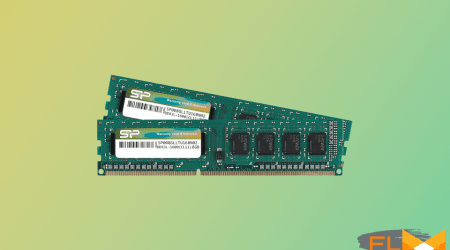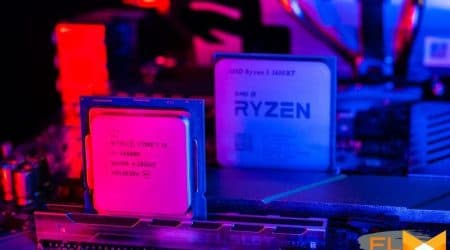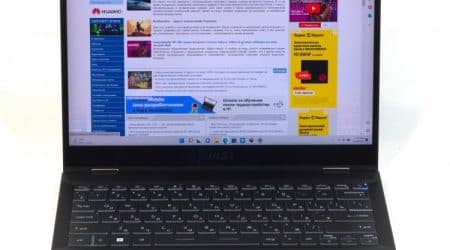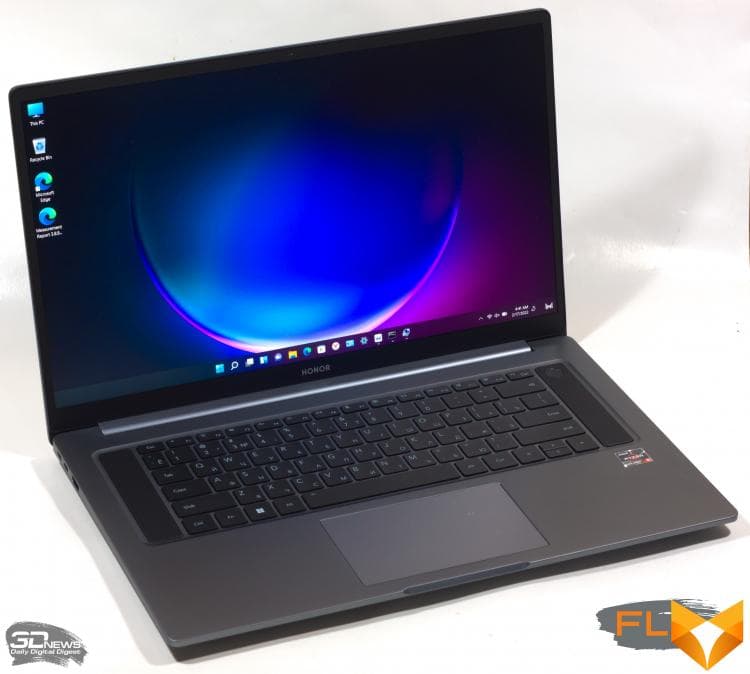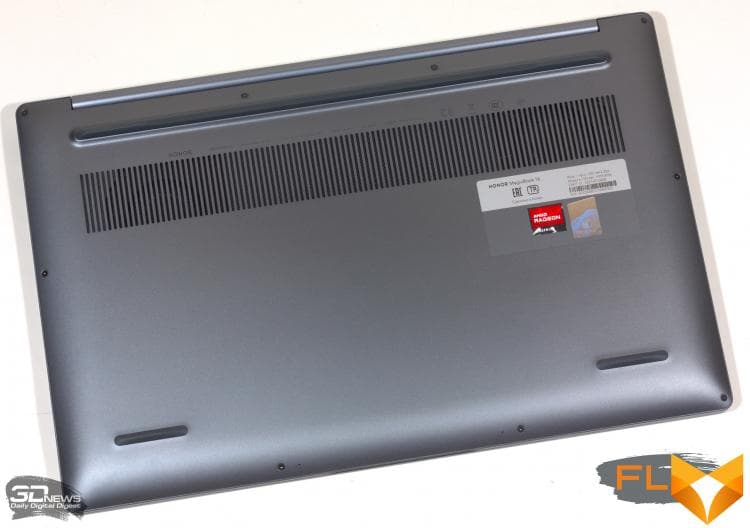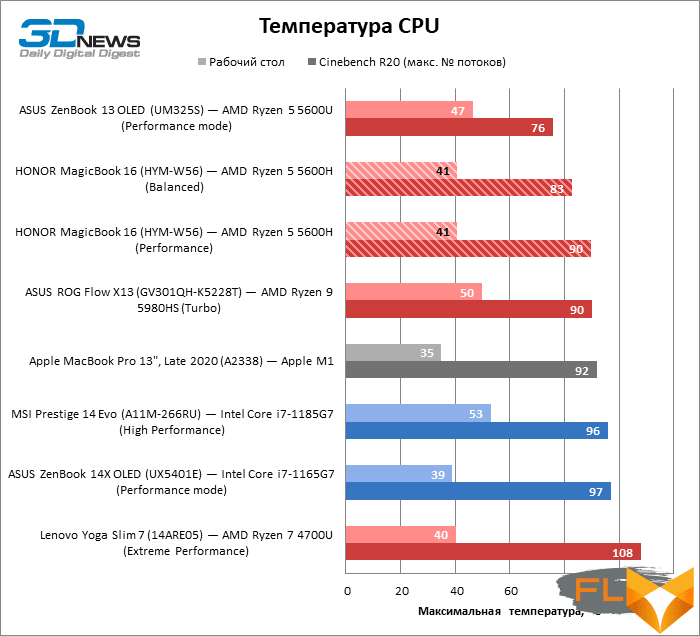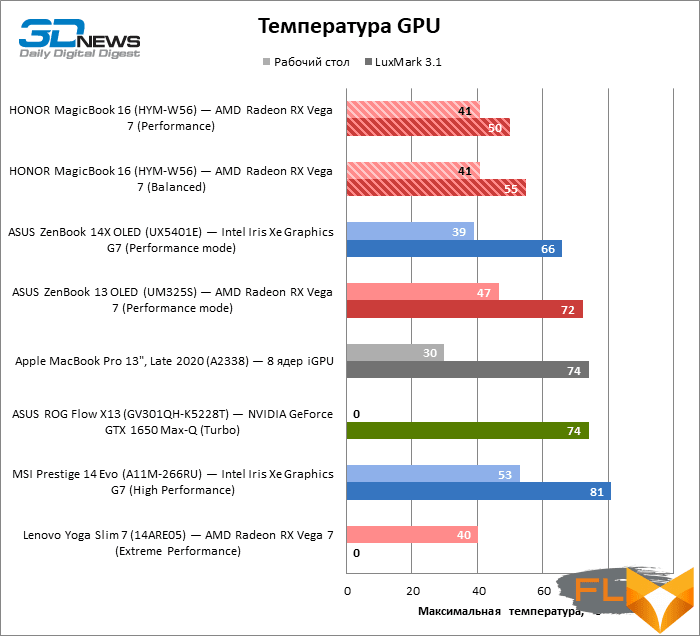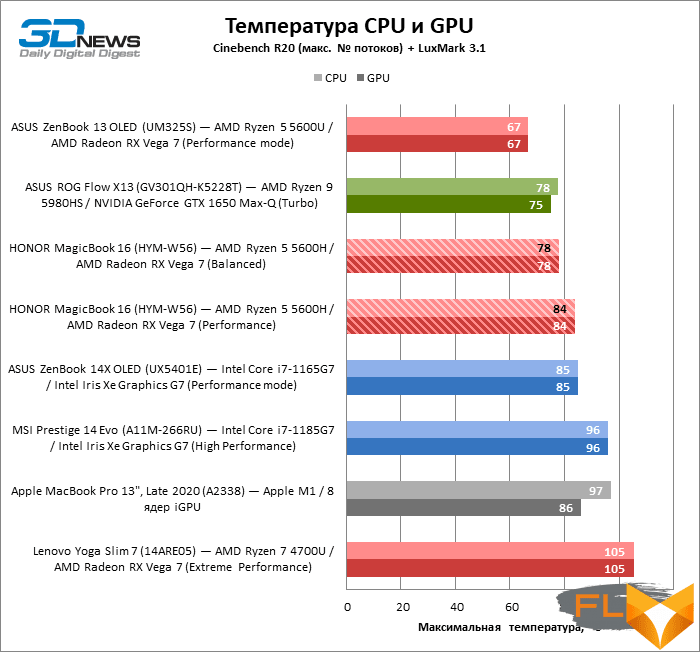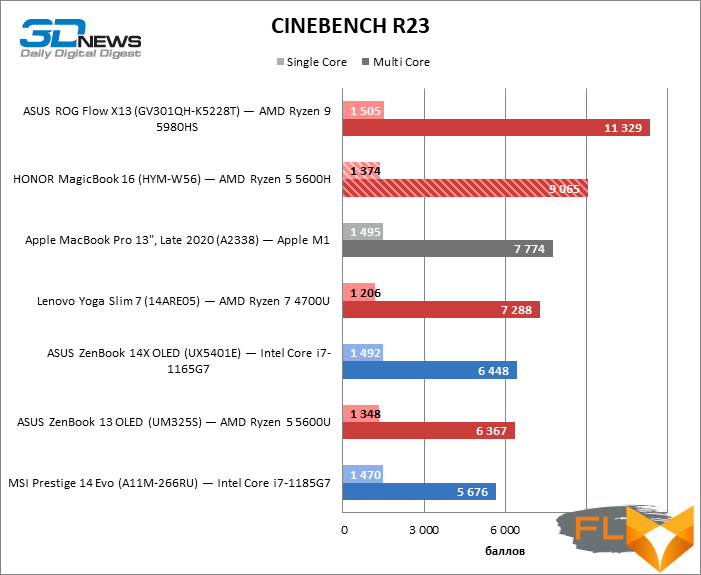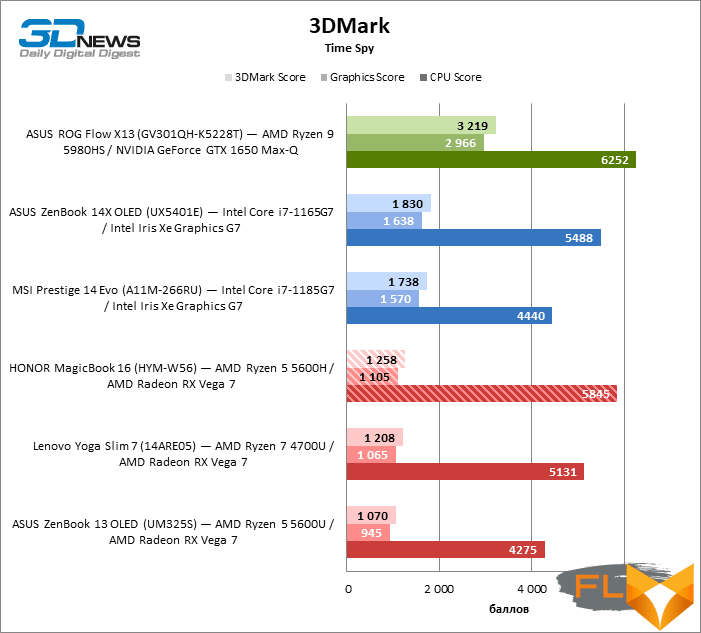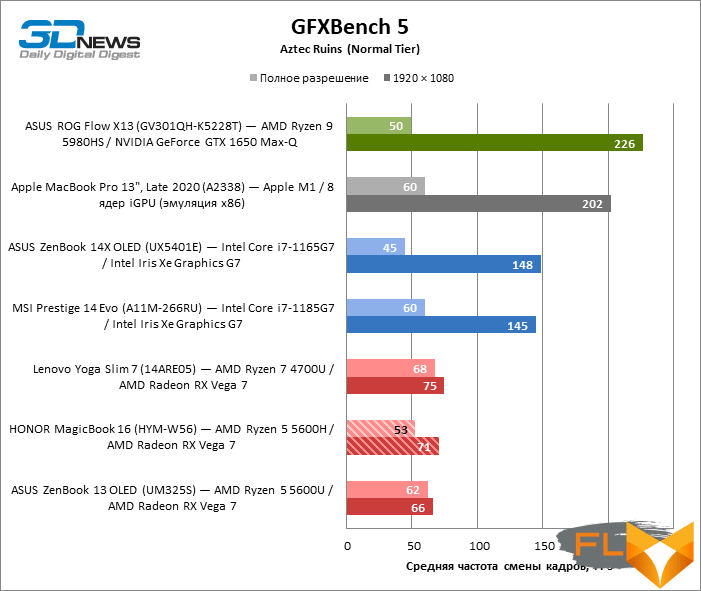


Since laptop manufacturers have learned to make screens with thin bezels, 14-inch displays have been systematically replacing the previously dominant 13-inch matrices. Well, now everything is going to the fact that 16 inches will replace the once popular 15.4 in the same way, even if we are not talking about gaming machines or mobile workstations, but about devices of such a relatively rare class as a large ultrabook. And even if we talk about inexpensive offers: MagicBook 16 is another example of this. However, it cannot be said that the HONOR product is an ultrabook in the typical sense of the word. Where the MagicBook 16 differs from its siblings, besides the screen size, is the powerful CPU that takes the place of the typical low-wattage AMD and Intel chips.

⇡#Specifications, prices
HONOR MagicBook 16 does not allow any variation in the list of components. HONOR used a six-core Ryzen 5 5600H chip as the CPU. Pay attention to the H mark – it means that the CPU power consumption can reach 54 W, while the U processors, which are used in the vast majority of “red” ultrabooks, are limited to 35 W. Provided that the power and cooling systems of the MagicBook 16 meet these parameters (and if we jump a little ahead and judge by the results of the tests, they do), the x86 cores in the Ryzen 5 5600H die, even under multi-threaded load, maintain significantly higher clock speeds than their sibling. Ryzen 5 5600U, and all other low-wattage AMD chips.
Thus, the performance potential of the CPU makes the MagicBook 16 related to powerful all-round laptops, however, like most inexpensive ultrabooks, this machine lacks a discrete graphics processor, which limits its capabilities in games and some professional tasks.
| Manufacturer | HONOR |
|---|---|
| Model | MagicBook 16 (HYM-W56) |
| Display | 16.1”, 1920 × 1080, IPS |
| CPU | AMD Ryzen 5 5600H (6/12 cores/threads, 3.3-4.2GHz) |
| RAM | DDR4 SDRAM, 3200 MT/s, 16 GB |
| GPU | AMD Radeon RX Vega 7 (512 MB from system memory) |
| Accumulator | Samsung PM9A1 (PCIe 3.0 x4) 512 GB |
| External I/O connectors | 2 × USB 3.2 Gen 1 Type-A; 2 x USB 3.2 Gen 1 Type-C; 1 x HDMI; 1 x TRS 3.5mm |
| Network | IEEE 802.11ax; Bluetooth 5.1 |
| Battery capacity, Wh | 56 |
| Weight, kg | 1.84 |
| Overall dimensions (L × W × H), mm | 368 × 236 × 18.2 |
| Retail price | $1300 – honor.ru |
The amount of RAM is quite sufficient for most users 16 GB. The 512 GB solid state drive also looks very acceptable. However, if the MagicBook 16 is the main or only computer, the opportunity to buy a laptop with 1 GB of ROM would come in handy. The SSD chosen by HONOR supports the 4th generation PCI Express bus, while the Ryzen 5000 series processors are limited to PCI Express 3.0, but you should not worry about this: at half a terabyte, this drive (Samsung PM9A1) has enough bandwidth abilities of the “obsolete” interface.
The screen resolution of 1920 × 1080 is not the ultimate dream for a 16.1-inch matrix, but it is more of a standard, especially for relatively inexpensive laptops. Finally, the MagicBook 16’s battery is rated at 56Wh, while the chassis dimensions would allow it to be pushed up to the 99Wh limit allowed by the airlines. However, it is a sin to complain about all these limitations, knowing the price of the device. The official HONOR store offers a laptop for $1,300.
⇡#Look and Ergonomics
The body of the HONOR laptop, with the exception of the frame around the screen, is assembled entirely from aluminum panels. The screen itself is not laminated, and this is a plus and a minus of the design at the same time. On the one hand, the glass layer on top of the matrix adds aesthetics to the device and makes the screen cover sandwich more bendable. On the other hand, there are quite a few users who are willing to forgive everything for the sake of a matte anti-glare coating – and the MagicBook 16 display is just right for them. As a result, there are no versions of the MagicBook 16 with a touch-sensitive screen, and the hinge mechanics prevent the laptop from being used in tablet mode. It is also impossible to tilt the lid 180 degrees. And lift with one hand, without holding the mating part of the body, by the way, too.
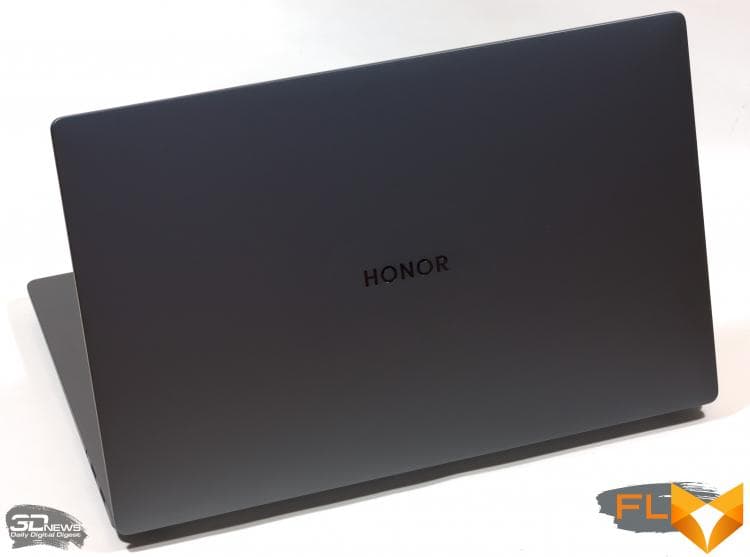
Note that a large screen with a diagonal of 16.1 inches instead of the standard 15.4 has one not entirely obvious advantage. We remain of the opinion that typical 16:9 screen proportions do not fit well with the small dimensions of mobile computers, however, the high height of the 16.1-inch matrix made it possible to reduce the indentation from the edges of the lid at the top and bottom without compromising the size of the keyboard and touchpad.
With such an area of the working surface of the MagicBook 16, it could well accommodate a keyboard with a number pad, but HONOR engineers decided that this was not necessary. Instead, a lot of space is occupied by the grilles of the built-in speaker system on the sides of the keyboard. The absence of a digital block will surely alienate some potential laptop owners, but there are many users who, on the contrary, only interfere with it – they prefer the large format of the main keys. The only strange thing is that the “~” key here is still smaller in width than all the others.
The key mechanics of the MagicBook 16 can be described as quite satisfactory, especially in the context of the laptop’s price. For the taste of the reviewer, the cones under the keys are too soft, but the actuation moment is well felt, and the covers quickly return to the neutral position, which the keyboards of more expensive devices often cannot boast of. It is a pity that the MagicBook 16 has not been spared the ubiquitous problem: the soft body under the keyboard trembles during typing and lubricates tactile feedback, but it could not be otherwise, given the dimensions of the chassis and, as the autopsy below shows, the free layout of the insides. The keys have a backlight with two levels of brightness (to be honest, a little even at the maximum level).
The touchpad is glass, which is gradually becoming the norm even for economy laptops, but compared to the keyboard, it is not as good in terms of mechanics. The fact is that the right side of the panel is not fixed in the case as firmly as the left side, and noticeably deforms before the touchpad registers pressing in the lower right corner. But the manipulator is set up quite qualitatively: input delay is not felt, cursor breakdowns rarely occur.

MagicBook 16 has a set of wired interfaces that is quite sufficient for most users: two USB Type-A ports on the right side and two Type-C ports on the left. Any of the latter can also be used to charge the battery. True, it should be noted that all USB connectors here work in 3.2 Gen 1 mode. In addition, there is a full-length HDMI and a 3.5 mm mini-jack for connecting external speakers or a headset.

The laptop is powered by a small custom 65W power supply with a USB Type-C connector. According to the manufacturer, it takes 30 minutes to charge the battery up to 50% from zero, and the full capacity is restored in 1.5 hours.

⇡#Internal design and upgrade options
There is a lot of free space inside the MagicBook 16 case – mainly due to the fact that HONOR used a small capacity battery, 56 Wh. However, laptop upgrade options are surprisingly limited compared to what is commonly expected from machines with a screen diagonal of 15.4-17 inches. RAM – despite the fact that these are DDR4 chips, not LPDDR4 (X) – is soldered on the motherboard. However, a computer that is not designed for complex games or work applications will have enough 16 GB of RAM for a long time. But an additional SSD slot would not hurt at all, especially considering that the MagicBook 16 configuration does not offer other capacities than 512 GB.
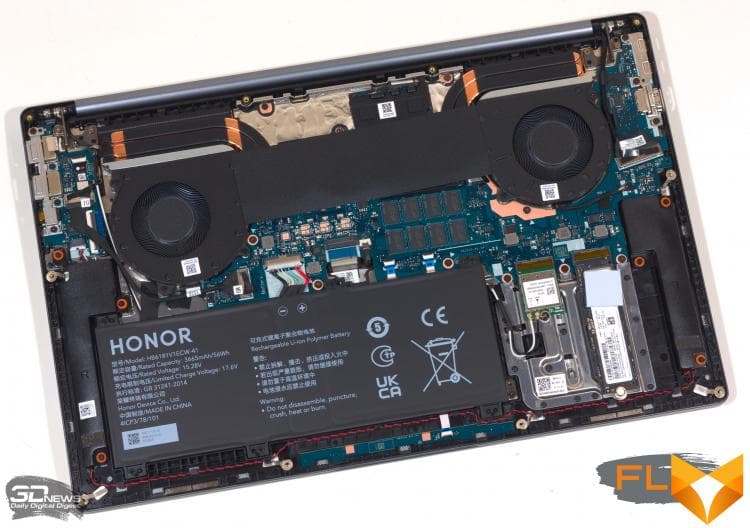
Nevertheless, opening the laptop left a positive impression. Firstly, the cooling system with two fans in appearance (and if we run a little ahead, then not only in appearance) is quite consistent with the power consumption of the processor. And secondly, the creators of MagicBook 16 took care of the strength of the external connectors, reinforcing them with metal plates.
⇡#Test Methodology
| Synthetic tests | |
|---|---|
| Application | Settings |
| 3DMark Time Spy | — |
| Geekbench 5 | — |
| CINEBENCH R23 | — |
| GFXBench 5 (Aztec Ruins – Normal Tier, High Tier) | Windows: Vulkan, macOS: Metal |
| fio 3.16 | Sequential Read/Write, Random Read/Write (Unbuffered I/O) |
| Work Applications | |||||
|---|---|---|---|---|---|
| Application | Benchmark | Settings/Notes | API | ||
| Intel Graphics | AMD Graphics | NVIDIA Graphics | |||
| Adobe Photoshop 2021 (22.4) | PugetBench for Photoshop 0.93 (list of tests at the link) | — | OpenGL + OpenCL + Metal (macOS) | OpenGL + OpenCL + Metal (macOS) | OpenGL + OpenCL |
| Adobe Photoshop Lightroom Classic 10.2 | PugetBench for Lightroom Classic 0.92 (list of tests at the link) | — | DirectX 12 (Windows) | DirectX 12 (Windows) | DirectX 12 |
| Adobe Premiere Pro 2021 (15.0) | PugetBench for Premiere Pro V0.95.1 (the composition of the tests at the link) | Standard Benchmark (4K) | OpenCL (Windows)/Metal (macOS) | OpenCL (Windows)/Metal (macOS) | CUDA |
| Blender 2.9x | Class Room Demo from Blender Foundation | Cycles renderer.
Feature Set: Supported. Tile size: 32 × 32 (CPU) or 256 × 256 (GPU) |
N/A (CPU rendering) | OpenCL (Windows)/CPU (macOS) | CUDA/OptX |
Display testing is performed using the X-Rite i1Display Pro Plus colorimeter in the DisplayCAL 3 application.
Notebook battery life is measured at a display brightness of 200 cd/m2 in the following usage scenarios:
- web surfing: alternately opening and closing tabs of Computeruniverse.ru and Unsplash.com sites with an interval of 25 seconds in the Google Chrome browser (cache and cookies are disabled);
- Continuous playback of 4K HEVC (H.265) video.
⇡#Test participants
The following devices took part in testing:
| Screen | CPU | RAM | GPU | SSD | HDD | Battery | |||
|---|---|---|---|---|---|---|---|---|---|
| HONOR MagicBook 16 (HYM-W56) | 16.1”, 1920 × 1080, IPS | AMD Ryzen 5 5600H | 6/12 cores/threads, 3.3-4.2 GHz | DDR4 SDRAM, 3200 MT/s, 16 GB | AMD Radeon RX Vega 7 | 512 MB from system RAM | Samsung PM9A1 (PCIe 3.0 x4) 512 GB | No | 56 Wh |
| Apple MacBook Pro 13″, Late 2020 (A2338) | 13.3”, 2560 × 1600, IPS | Apple M1 | 4+4 cores/threads, ≤3.2 GHz | LPDDR4X SDRAM, 4266 MT/s, 16 GB | 8 iGPU cores | System RAM | Apple AP2048Q (Apple Fabric) 2048 GB | No | 58.2 Wh |
| ASUS ROG Flow X13 (GV301QH-K5228T) | 13.4”, 3840 × 2400, IPS | AMD Ryzen 9 5980HS | 8/16 cores/threads, 3.1-4.8 GHz | LPDDR4X SDRAM, 4266 MT/s, 32 GB | NVIDIA GeForce GTX 1650 Max-Q | 4GB GDDR6 | WD PC SN530 (PCIe 3.0 x4) 1024 GB | No | 62 Wh |
| ASUS ZenBook 13 OLED (UM325S) | 13.3”, 1920×1080, OLED | AMD Ryzen 5 5600U | 6/12 cores/threads, 2.3-4.2 GHz | LPDDR4X SDRAM, 4266 MT/s, 16 GB | AMD Radeon RX Vega 7 | 512 MB from system RAM | SK Hynix PC711 (PCIe 3.0 x4) 512 GB | No | 67 Wh |
| ASUS ZenBook 14X OLED (UX5401E) | 14”, 2880 × 1800, OLED | Intel Core i7-1165G7 | 4/8 cores/threads, 2.8-4.7 GHz | LPDDR4X SDRAM, 4266 MT/s, 16 GB | Intel Iris Xe Graphics G7 | 1 GB from system memory | Samsung PM9A1 (PCIe 4.0 x4) 1024 GB | No | 63 Wh |
| Lenovo Yoga Slim 7 (14ARE05) | 14”, 1920 × 1080, IPS | AMD Ryzen 7 4700U | 8/8 cores/threads, 2.0-4.1 GHz | LPDDR4X SDRAM, 4266 MT/s, 16 GB | AMD Radeon RX Vega 7 | 512 MB from system RAM | UMIS RPITJ256VME2MWD (PCIe 3.0 x4) 256 GB | No | 60 Wh |
| MSI Prestige 14 Evo (A11M-266RU) | 14″, 1920 × 1080, IPS | Intel Core i7-1185G7 | 4/8 cores/threads, 3.0-4.8 GHz | LPDDR4X SDRAM, 4266 MT/s, 16 GB | Intel Iris Xe Graphics G7 | 1 GB from system memory | Phison 1TB SM2801T24GKBB4S-E162 (PCIe 4.0 x4) 1024 GB | No | 52 Wh |
⇡#Screen Quality
The screen of the HONOR MagicBook 16 does not boast a high resolution for a 16.1-inch diagonal (only 1920 × 1080), but otherwise it is a very high-quality matrix, especially by the standards of relatively inexpensive mobile computers, which this laptop belongs to. It has a good margin of brightness of 328 cd/m2 and a high contrast ratio of 1048:1. The color range of the screen almost completely covers the sRGB space.

The color temperature is a bit on the high side of the standard 6500K, but this can be painlessly remedied thanks to the near-perfect gray balance across the entire gray scale (except for the darkest tones).

The only obvious drawback of the MagicBook 16 screen is related to gamma correction: the shape of the curve, laid down at the factory setting of the matrix, underestimates the contrast in the areas of the image of medium and high brightness.
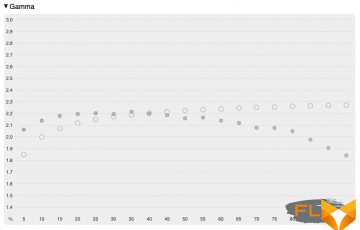 |
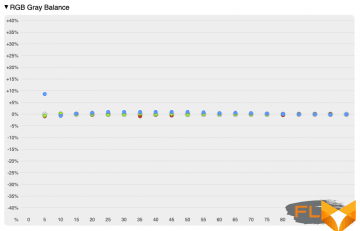 |
However, color temperature-adjusted color accuracy, as expected with a near-perfect gray balance, on the HONOR MagicBook 16 is excellent by consumer-grade standards.

⇡#Clock speeds, temperature and noise levels
The Ultrabook’s Category H Ryzen CPU is a solution similar to the overclocked Tiger Lake chips that other mobile computer manufacturers use in their products. The difference is that the Ryzen 5 5600H, according to formal specifications, is designed for power consumption up to 54 W, and most importantly, it contains six x86 cores instead of Intel’s four. The MagicBook 16 control software allows you to set the power consumption to balanced or performance mode. In the latter case, the Ryzen 5 5600H processor consumes just 54 watts of power during a long multi-threaded load and, accordingly, maintains high clock speeds of about 3.7 GHz. But the integrated graphics Radeon RX Vega 7 did not derive any practically significant advantage from the increased TDP: its clock speed is typical for this GPU 1.8 GHz. With a combined load on the CPU and GPU, the clock speed of the x86 cores drops slightly – to 3.6 GHz, and the graphics drops to 1.45 GHz.
In this mode, the MagicBook 16 cooler provides adequate cooling for the processor, keeping the crystal temperature within the 90 ° C range that is quite acceptable for a laptop, but, as you might expect, it makes a lot of noise: in terms of noise level under maximum load, the HONOR laptop surpasses most of the ultrabooks known to us.
| Load Clock | ||||||||
|---|---|---|---|---|---|---|---|---|
| Cinebench R20 (Max Thread #) | Blender 2.9x | Cinebench R20 (max thread no.) + Blender 2.9x | ||||||
| CPU clock speed, MHz | GPU clock speed, MHz | CPU clock speed, MHz | GPU clock speed, MHz | |||||
| Medium | Max | Medium | Max | Medium | Max | Medium | Max | |
| HONOR MagicBook 16 (HYM-W56) – AMD Ryzen 5 5600H / AMD Radeon RX Vega 7 – Balanced | 3582 | 3618 | 1800 | 1800 | 3413 | 3581 | 1334 | 1800 |
| HONOR MagicBook 16 (HYM-W56) – AMD Ryzen 5 5600H / AMD Radeon RX Vega 7 – Performance | 3717 | 3751 | 1800 | 1800 | 3587 | 3639 | 1442 | 1800 |
| CPU and GPU power consumption | ||||||||
|---|---|---|---|---|---|---|---|---|
| Cinebench R20 (Max Thread #) | Blender 2.9x | Cinebench R20 (max thread no.) + Blender 2.9x | ||||||
| CPU power consumption, W | GPU power consumption (SoC as a whole, if integrated), W | CPU power consumption, W | GPU power consumption (if discrete), W | |||||
| Medium | Max | Medium | Max | Medium | Max | Medium | Max | |
| HONOR MagicBook 16 (HYM-W56) – AMD Ryzen 5 5600H / AMD Radeon RX Vega 7 – Balanced | 45 | 45 | 12 | 20 | 45 | 47 | N/A | N/A |
| HONOR MagicBook 16 (HYM-W56) — AMD Ryzen 5 5600H / AMD Radeon RX Vega 7 — Performance | 54 | 58 | 11 | 12 | 54 | 57 | N/A | N/A |
Note The measurement is performed after the device has warmed up and all parameters have stabilized.
The balanced mode reduces the power consumption of the CPU to 45 W, but this is hardly felt in terms of performance: the clock frequency of the x86 cores is still high, about 3.6 GHz, and the integrated GPU is 1.8 GHz. With a combined load, the parameters are 3.4 and 1.3 GHz, respectively. The temperature of the chip in the “balanced” mode does not exceed 83 ° C, and the computer no longer makes noise like at maximum speeds. However, it’s still a very noisy ultrabook and could do with the ability to limit CPU power even further for situations where silence is needed and high performance isn’t required.
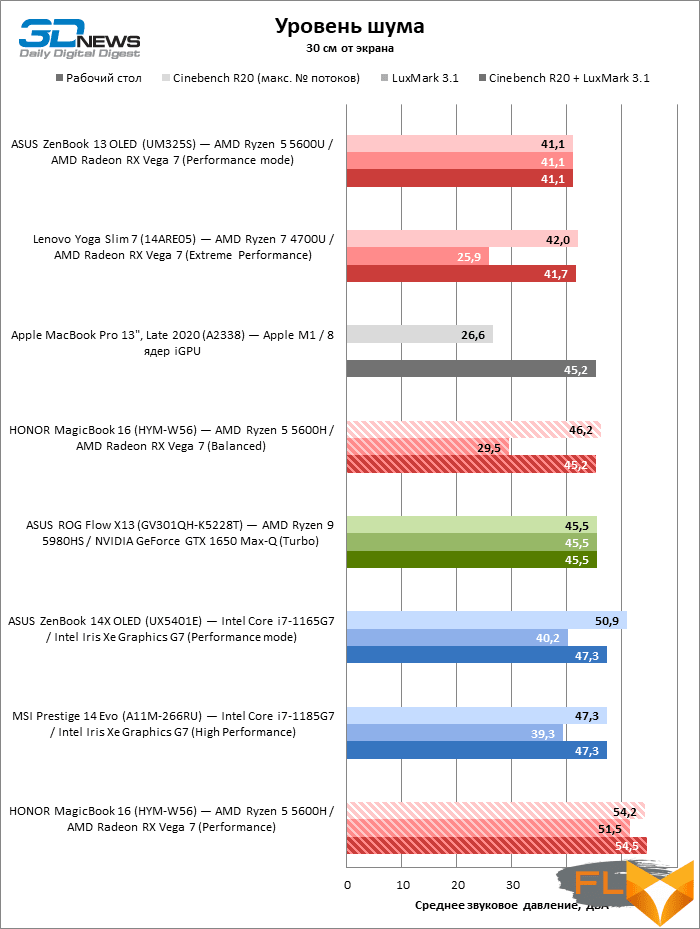
⇡#Synthetic performance tests
Equipped with a hexa-core Ryzen 5 5600 Category H processor, it’s no surprise that the HONOR MagicBook 16 is known to outperform both low-wattage AMD laptops and Intel-based thin mobile computers that can’t afford more than four Tiger Lake cores in sheer performance. Only AMD octa-cores, also marked H, and in some cases Apple M1 can offer the best multi-threaded performance. It would be interesting to bring devices based on fresh Intel Alder Lake chips for comparison, but such ultrabooks are still few in number and we have not yet come across. And as usual, we note that Tiger Lake, even though it is already formally obsolete silicon, remains competitive in single-threaded load conditions.

The integrated graphics of the Radeon RX Vega 7 does not look very impressive against the background of Intel solutions, and even more so the GPU built into the Apple M1 processor. However, for most applications that will run on a laptop of this class, this does not really matter.
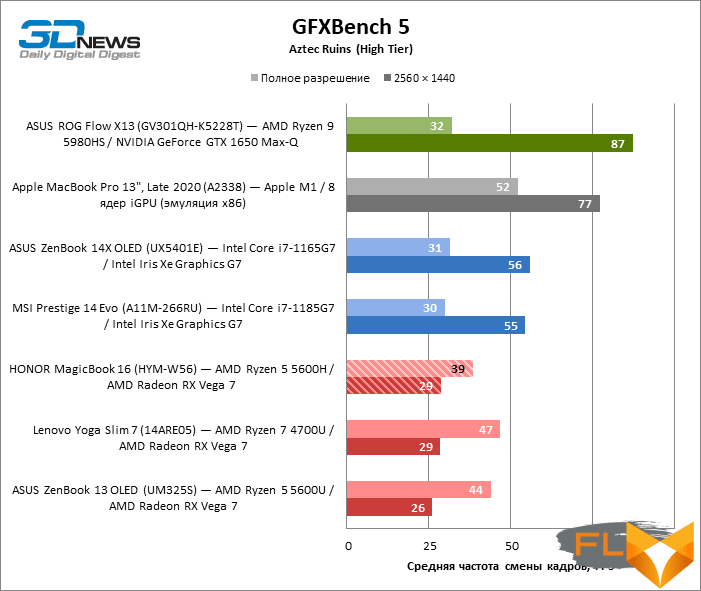
Note that HONOR MagicBook 16 was the first ultrabook in our practice, which was preinstalled with the Windows 11 operating system. Knowing that the security settings in the new OS, which are active by default, have a negative impact on performance, we disabled them (and will continue to disable them). in upcoming reviews) to ensure a level playing field between Windows 10 and Windows 11 PCs and to showcase the best performance from new machines. The options we are interested in are called VBS (Virtualization-Based Security) and Memory Integrity (Hypervisor-protected Code Integrity).
⇡#Performance in production applications
The database of test results in real work applications that we have collected using the updated test methodology is still quite limited, but configurations of modern ultrabooks without a discrete GPU do not differ much. To evaluate the performance of the HONOR MagicBook 16, it is enough to compare laptops based on the low-wattage six-core Ryzen category U, as well as the eight-core Ryzen H, on the one hand, and the older Intel models of the Tiger Lake family, on the other.
In Blender’s CPU-rendered MagicBook 16 benchmark, the Ryzen 5 5600H is well ahead of its low-wattage Ryzen 5 5600U counterpart and Intel’s quad-core solutions (especially those limited by low power headroom) and comes close to the powerful octa-core Ryzen .
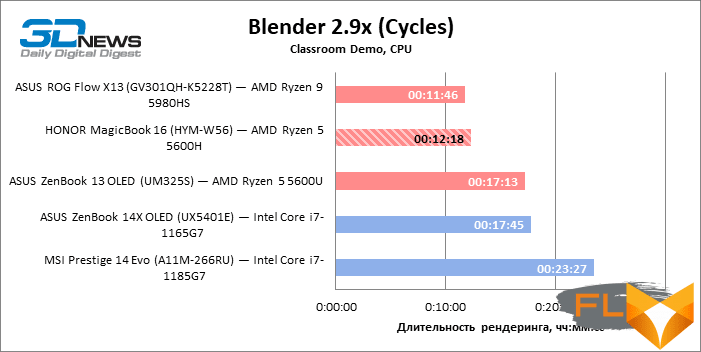
Load shifting from x86 cores to the integrated Radeon RX Vega 7 GPU does not give the Ryzen 5 5600H any advantage in Blender and in fact only reduces performance. However, the Radeon RX Vega 7 is no longer as far behind the integrated Tiger Lake graphics in workloads as it is in regular 3D rendering.
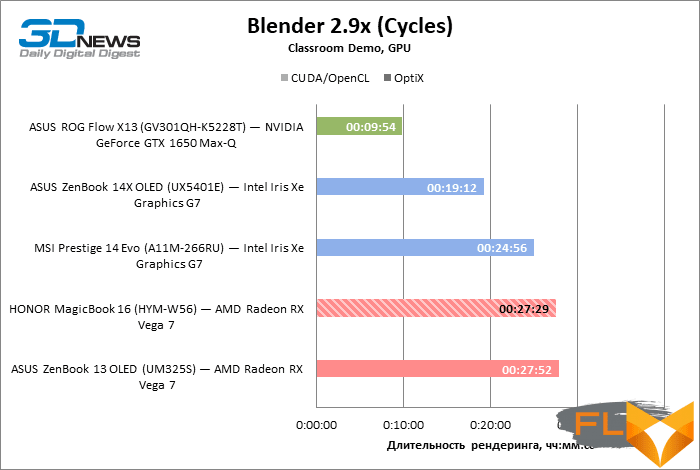
The benchmarks of Adobe graphics editors are usually dominated by Intel’s mobile processors, even despite the clear advantage of AMD in the number of x86 cores. However, the power headroom available to the Ryzen 5 5600H chip easily offsets Lightroom’s better optimization factor for Intel architecture, even though competing laptops are not that far behind the HONOR MagicBook 16 in test points.

Note Scores are calculated as a percentage of Intel Reference Workstation performance Core i9-9900K, NVIDIA GeForce RTX 2080, 64GB RAM.
The same situation has developed in the Photoshop benchmark. The large power headroom allowed the six-core Ryzen chips to significantly strengthen their position compared to the quad-core Tiger Lake and pushed the MagicBook 16 laptop to the top of the benchmark chart.
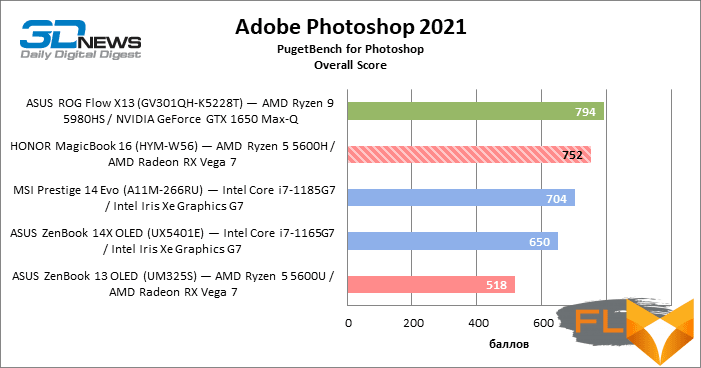
Note Scores are calculated as a percentage of Intel Reference Workstation performance Core i9-9900K, NVIDIA GeForce RTX 2080 and 64GB RAM x 10.

Note Scores are calculated as a percentage of Intel Reference Workstation performance Core i9-9900K, NVIDIA GeForce RTX 2080, 64GB RAM.
But video processing in the Premiere Pro editor is still best handled by Intel chips. Compared to the 6-core Ryzen Category U, the same more powerful chip performs project export and graphic effects faster, but still cannot maintain high frame rates during live playback of recordings. And of course, the absence of a discrete graphics processor in the MagicBook 16 is more acutely felt here than ever.
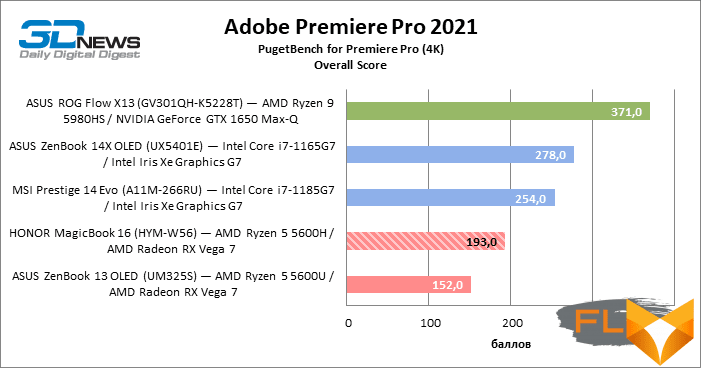
Note Scores are calculated as a percentage of AMD reference workstation performance Ryzen 9 5900X, NVIDIA GeForce RTX 3080 and 64GB RAM x 10.

Note Scores are calculated as a percentage of the performance of the reference workstation and with AMD Ryzen 9 5900X, NVIDIA GeForce RTX 3080 and 64GB RAM.
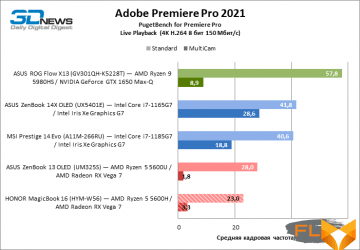 |
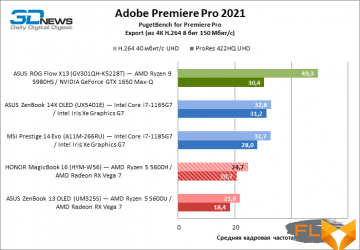 |
⇡# SSD Performance
The Samsung PM9A1 SSD that is installed in the MagicBook 16 can use the 4th generation PCI Express bus, but the Ryzen 5000 series platform does not have this capability. However, at 512 GB, this SSD does not develop enough bandwidth to require a wider communication channel with the SoC than four PCI Express 3.0 lanes. Even the terabyte version of Samsung PM9A1 will allow you to experience the benefits of the new standard only in sequential read mode with a long command queue. With a short queue typical for desktop tasks, the difference between the two generations of PCI Express is no longer significant from a practical point of view.
In the linear write test, the HONOR MagicBook 16 is as fast as similar machines with PCI Express 3.0 bus and achieves excellent random read and write speeds thanks to a powerful CPU.
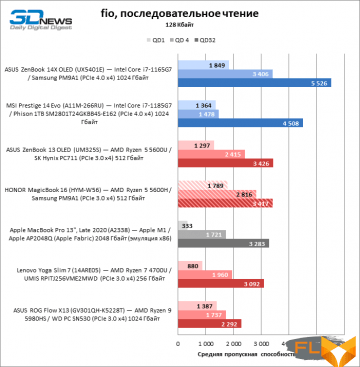 |
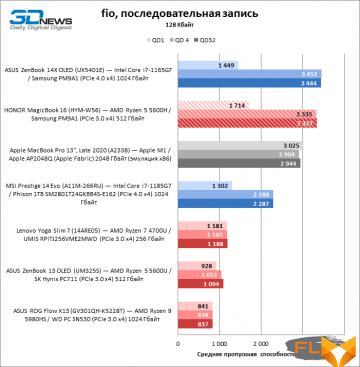 |
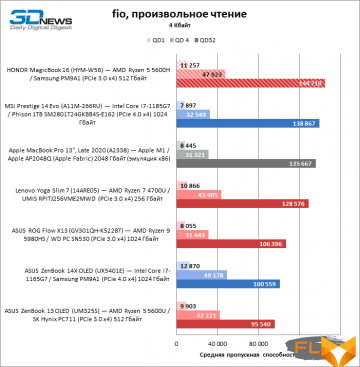 |
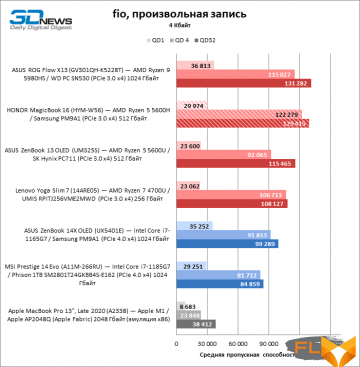 |
⇡# Battery Life
Since the HONOR laptop has a very powerful and powerful CPU and a rather small battery, the battery life leaves much to be desired: just under seven hours of continuous web surfing or six hours of HEVC video playback at a screen brightness of 200 cd/m2 . However, the main reason for the rapid charge consumption is not even in the laptop components, but in the fact that its control software does not contain an energy-saving mode that could reduce the CPU power to the level of Ryzen U-series chips.
⇡#Conclusions
HONOR MagicBook 16 is an intermediate link between ordinary ultrabooks and more powerful universal laptops. The main feature of the HONOR product is, of course, a large and, by the way, very high-quality screen measuring as much as 16.1 inches instead of the standard 15.6. However, unlike most compact machines and similar oversized ultrabooks, the MagicBook 16 contains a Category H Ryzen 5 CPU that delivers up to 54W of power, and this is clearly visible in performance tests. Other than specific models with the right cooling system and correspondingly high price, typical compact laptops can’t match the performance of the MagicBook 16 in heavy multi-threaded workloads.
However, the MagicBook 16 still has a lot in common with classic ultrabooks, and ultrabooks in the budget category. It doesn’t have even an entry-level discrete GPU, and the built-in Radeon RX Vega 7 graphics core is only suitable for the most undemanding games and limits the laptop’s potential in work applications such as video editors. It must also be admitted that when the entire reserve of power of the central processor is used, the computer runs very loudly, and, unfortunately, the control software does not contain truly quiet power consumption settings. Another sign of the economy class in MagicBook 16 is the configuration of external interfaces: Thunderbolt laptops on the AMD platform still do not shine in principle, and all USB ports here are limited to 3.2 Gen 1 speed mode. Finally, let’s complain about the rapid consumption of battery capacity offline.
But at the end of the day, the HONOR MagicBook 16 is a really inexpensive laptop, and for the price, it can offer more than just a powerful CPU and a large screen. The novelty looks presentable, it has far from the worst keyboard with a touchpad, and a biometric sensor is integrated into the power button.
